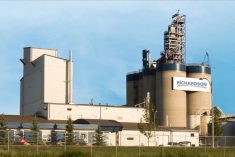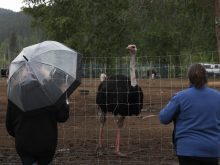SOUTHWEST
Rainfall put a damper on seeding efforts while cool conditions slowed crop growth, but crops are quickly emerging.
Most areas reported 15 to 30 millimetres of rain.
Unseeded acres will average five to 10 percent, but some farms will see 25 to 30 percent.
Seeding is almost finished, but the southwestern corner is only 30 to 40 percent complete.
Producers are applying fungicide and herbicide for early seeded cereals showing moisture stress and disease.
Fall rye is heading, and most winter wheat is in the flag leaf stage. Most broadcast seeded canola has emerged. Pressure from insect damage is generally low.
Read Also

U.S. criticizes Mexico’s handling of screwworm near border
U.S. Agriculture Secretary Brooke Rollins on Thursday said Mexico has not adequately enacted protocols to curb the spread of New World screwworm.
The lack of heat and sunshine is slowing forage growth, but pastures are growing well. Most alfalfa stands are in the early to mid bud stage. Dairy producers have started their first cut of silage, and commercial hay growers will be soon cutting.
NORTHWEST
Twelve to 51 mm of rain continued to restrain seeding efforts, and many fields have standing water in low-lying areas. Excessive topsoil moisture has some producers looking for higher ground that could support seeding equipment. Seeding on average is almost completed.
All crops are showing good germination and even emergence, despite excess moisture. Producers are also applying in-crop herbicide. Reports of insect activity remain low.
Dandelion growth is an issue in some hayfields and pastures, while forage growth has been slow because of below average temperatures.
Dugouts in some areas have overflowed their banks onto surrounding fields.
CENTRAL
Seeding is basically completed, but some crops are stagey in areas because of the stops and starts caused by rain.
Most areas saw cool temperatures with precipitation of 40 to 60 mm. Standing water is quickly being absorbed in many cases, but any amount on saturated soil shuts down field operations.
Crops are generally growing well with good, even emergence. Several pea fields required rolling after emergence because of rapid germination and the number of acres to complete, or at the unaffiliated stage.
Herbicide applications are complete on winter wheat, and most cereals have been sprayed.
Fields are stagey, which will make fungicide applications a challenge to time properly. Second applications or broadleaf applications are being made in most canola fields. Most soybeans have seen the first application.
Pressure from flea beetles and cutworms continues but is beginning to wane in most areas. However, some fields had to be reseeded.
Diamondback and bertha armyworm moth numbers remain low, but high numbers of grasshoppers have been reported in some areas.
EASTERN
Rainfall ranging from 40 to 105 mm brought seeding to an end, which leaves five to 10 percent unseeded. Most topsoil moisture conditions are rated surplus to adequate. Many fields have standing water.
Excess rainfall is preventing fungicide applications on most fields.
Flea beetles in canola are still causing concerns with some post-emergent spraying and reseeding occurring.
There are reports of cutworms in sunflowers, corn and canola. Grasshopper nymphs are found with extensive damage on some field margins.
Many fields of alfalfa are being cut, but having is slowing down because of soggy conditions.
INTERLAKE
Seeding is generally complete with trace amounts of specialty crops remaining, but excess moisture and unseasonably cool temperatures are slowing production.
Accumulated rainfall across the area ranged from 35 to 75 mm. Field drains are full in some places with road ditches and water drains close to full.
Recent precipitation is delaying herbicide applications for several days.
There are reports of sunflower damage caused by cutworms. Flea beetle damage in canola is slowly disappearing with cooler temperatures and increasing plant development.
















